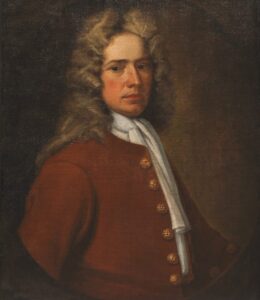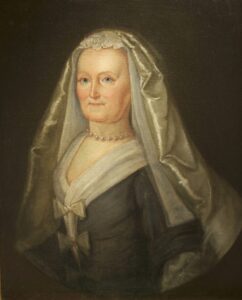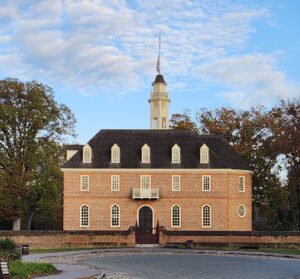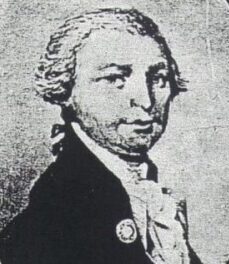The Establishment of Old Brick House and the Kennon Family
The early origins of the Kennon’s in Virginia is hard to trace. The best accounts of the earliest Kennons in Virginia are outlined in the book, Lewis of Warner Hall by Merrow Sorley. Records show a Richard and Elizabeth Canon sailed aboard the Truelove from Gravesend, England on June 10 1635 headed for Bermuda; it is likely that these were the earliest emigrant ancestors of the Kennon family. As early as 1637, records show a Richard Kennon in Lower Norfolk County, Virginia. It could be that this Richard Kennon was the father of Richard Kennon of Conjurer’s Neck. Research is currently underway in England to attempt to find the answers to the early origins of the Kennon family in Virginia.
The Richard Kennon of Old Brick House was born around 1650. In 1670, Richard Kennon, Francis Eppes, Joseph Royall and George Archer were granted 2827 acres of land in Henrico County. Richard had established himself at Bermuda Hundred and was engaged as a very profitable merchant. On October 19, 1677, Christopher Robinson, owner of Conjurer’s Neck, sold the plantation to Richard Kennon. Kennon soon established himself at what was now called “the Neck” but maintained his business operations at Bermuda Hundred. In April 1681, he also purchased 657 acres of land at Roxdale from William Byrd. Richard began a line of political office holders in the family, becoming a Justice of Henrico County in 1678 and a member of the House of Burgesses for the county in the Assembly of 1685-86. At the time that Richard Kennon was in the House of Burgesses, the colonial capital was still seated at Jamestown, where he likely travelled to for sessions. It would not be until 1699, that the colonial capital would be moved to Williamsburg.
By 1685, Richard had built a brick house at Conjurer’s Neck. Local lore says that Old Brick House got its name because it served as a prominent landmark for shipmasters as they came up the Appomattox River and that it was noted as “The Brick House” on their charts. The location of “the Brick House” on the Appomattox River was important as rivers were the highways of that era. Rivers allowed for businesses to grow and flourish, families to easily visit one another, trade to carry on, and provided food for all. There is a belief that the bricks used to build Old Brick House were imported from England. It is unknown when the current house was built, but there is a story that a brick in one of the walls was found with the date of 1686. Mark Wenger of the Colonial Williamsburg Foundation did a survey of the house and suggested a date between 1725 and 1750 for the house’s construction. Ultimately, determining the age of the house is difficult because of a fire that occurred in 1879.

He married Elizabeth Worsham, daughter of William and Elizabeth Littlebury Worsham. The couple would have 8 children; Mary, Elizabeth, Richard, William, Richard II, Martha, Judith, and Sarah. Richard’s eldest son, Richard, was born December 5, 1684 and died March 8, 1688 at the age of three; his grave marker is still at Old Brick House. All of the children who married, did so into prominent and well to do families such as the Bollings, Eldridges, Royalls, Eppes, and Munfords. In colonial Virginia, marrying well more often than not brought land, wealth, and political appointments which translated to power and prestige. One of the most significant connections of this first generation of Kennons is the connection to the Bolling family, one of Virginia’s most prominent families of the era. Richard Kennon married Agnes Bolling, the daughter of Robert Bolling and Anne Stith. The most notable marriage was that of Mary Kennon to John Bolling, son of Robert Bolling and Jane Rolfe. John Bolling was the only great grandson of John Rolfe and Pocahontas, the famed Powhatan princess and daughter of Wahunsonacock, Chief Powhatan. Any descendants of John Bolling and Mary Kennon are known as Red Bollings due to John’s descent from Pocahontas.


Richard Kennon devised Old Brick House to his eldest son, William, before his death in 1696. Richard’s will was proved on 20 August 1696 in Henrico County Court. His wife, Elizabeth would live out her remaining years at Old Brick House. As late as 1720, she was operating a ferry across the Appomattox between the falls and City Point. Rivers were the highways of their day, allowing for commerce and contact between neighboring plantations. It is unknown when Elizabeth died.
William Kennon, the eldest surviving son of Richard and Elizabeth Worsham Kennon, was next in line to ownership of Old Brick House and Conjurer’s Neck. In colonial Virginia, laws of primogeniture stipulated that the eldest sons received the home tracts and best parcels of land. William was born about 1685 at Conjurer’s Neck. Old Brick House and Conjurer’s Neck were devised to him by his father before his death, and on March 1, 1710, Conjurer’s Neck was deeded to him by his mother. Around this time, William married Ann Eppes, daughter of Colonel Francis Eppes.
1710 seemed to be a busy year for William Kennon. He became a vestryman of Dale Parish (and later Bristol Parish) and was appointed a Justice of Henrico County. He also held the title of Colonel, likely because he was an officer in the county militia, a common practice among the elite and leading families in Colonial Virginia. William and Anne would have five children, all sons, only two of which survived to adulthood and married and had families of their own. One of their sons, Henry Isham Kennon, (April 22, 1715-August 8, 1747) died unmarried and is buried at Old Brick House where his gravestone still resides.
As his father before him, William won election to the Virginia House of Burgesses for Henrico County, a seat he held from 1736 to 1740. In Colonial Virginia, seats in the House of Burgesses almost became hereditary. This is no different for the Kennons, as a number of the family served in this august body. Two of William’s sons would serve as Burgesses for Charles City County; Richard served 1738-1755, having succeeded to his seat upon the death of Burgess William Acrill in 1738 and William Jr. served 1758-1765. In 1699, the colonial capital was moved from Jamestown to Middle Plantation, which was renamed Williamsburg in honor of King William. It was here that William and other Kennon men travelled to take their seats in the colonial legislature. They would have likely lodged in one of the inns or taverns or with an associate who had a home in the colonial capital. It is unknown when William died, some references say 1735, some say 1751.

Old Brick House and the Conjurer’s Neck tract next passed to Richard Kennon, eldest son of Colonel William and Anne Eppes Kennon. This Richard was born April 15, 1712, likely at Old Brick House. He settled in Charles City County at a place called “Kennons”, opposite Brandon. He married Anne Hunt, daughter of William Hunt of Charles City County. The couple would have four children; John, Anne, Mary and William. Richard served as a justice of the county court and as a burgess for Charles City from 1738-1755, having taken the seat formerly held by William Acrill. Conjurer’s Neck became a part of newly formed Chesterfield County in 1749. Richard Kennon died in 1761 as his will was proved in Chesterfield County Court on July 19, 1761. In his will, he gave his son, John, 24 enslaved people and “Conjurer’s Neck”.
Old Brick House, the Revolutionary War and the last Kennons to own Conjurer’s Neck
With the death of his parents, John Kennon inherited Old Brick House and Conjurer’s Neck, the last Kennon male to do so. Surprisingly, little is known of John. John married a woman named Hannah, but currently, nothing more is known of her. They had a son, William, born June 5, 1742. With the outbreak of hostilities between Great Britain and her colonies, John enlisted in the Continental Army, serving as a Lieutenant in the 2nd Virginia Regiment. He died sometime in 1780, the circumstances of his death being unknown. A letter he wrote to his brother-in-law, Allen Cocke, on September 10, 1778, offers some details of how he wanted his property and belongings divided up in the event of his death in the Revolution. Allen Cocke married his sister Anne. Ultimately, his sisters, Anne and Mary, would inherit Old Brick House and Conjurer’s Neck, the last of the Kennons to own the land and home.
The Revolutionary War itself came to the doorstep of Old Brick House. In the spring of 1781, British Major General William Phillips ordered an attack on Petersburg, just a short way to the south. American Brigadier General Peter Muhlenberg ordered a company of 100 men commanded by Captain Fisher Rice to “Brick House” to act as outlook for the advance of Phillips’ troops moving up the River Road, on the opposite shore of the Appomattox River, across from Old Brick House. When British troops were sighted, they were out of musket range, but some British gunboats heading up the river were fired upon by Rice’s men. Training their guns on Rice’s men, the British gunboats drove them away and back to Petersburg, with the alarm to prepare for a British attack. Luckily, Old Brick House suffered no damage in this little scuffle.
